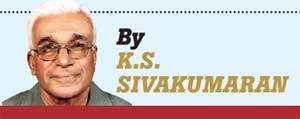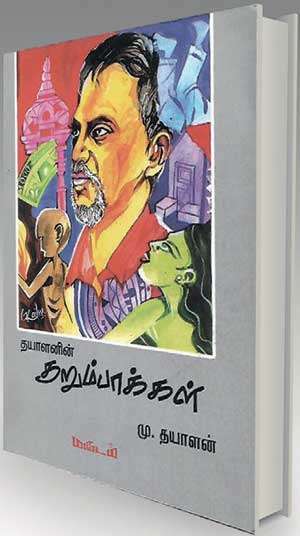04 Feb 2019 - {{hitsCtrl.values.hits}}
They could be equated to the limericks of English. But I wonder whether such poems strictly fit into the definition that a limerick is a five-line humorous poem. This is also true with regard to Haiku.
Leaving this presumption aside, let us look at what a Sri Lankan born British Thamil writer says in his 192-Page, (Illustrated by K. Kailaanathan)) book titled Thayalanin Kurumbaakal.
The Editor of literary magazine, Makudam Michael Collin and Prof. S. Yogarasa had given their views at the back of the book.
The front cover in colour by the well-known artist Kailasanathan is very impressive.
The poet is also a novelist, essayist and teacher. He had signed his works using different names like Karavaik Kavi, Natguna Thayalan and M. Thayalan.
His poems, essays, plays, short stories and poems written in English were included in his book titled Enathu Penavil Irunthu (From My Pen) in 2016.
 Also, in the same year, his novel Sila Manitharkalum Sila Niyayangalum (Some Humans and Some Justifications) was published.
Also, in the same year, his novel Sila Manitharkalum Sila Niyayangalum (Some Humans and Some Justifications) was published.
Previously in 2005, he wrote a novel called Kadal Kadanthu Ponavarkal (Those that crossed the seas). And a collection of essays titled Mannil Theriyutu Vaanam (The Sky is Seen on the Soil).
Natguna Thayalan runs a tuition centre called Lakshumi Tuition Centre to teach Physics and Maths to higher forms students in London. He has published more than 40 books on educational matters.
The editor of Makudam, Michel Collin and Prof. Yogarasa have brought out the essence of Thayalan’s poems n their short write-ups.
"Fearing damage to his originality I refrain from doing this.My main purpose in writing about books in Thamil is to introduce the existence of Sri Lankan Thamil Literature which forms a part of the whole."
According to Collin, Thayalan had touched on the caste system, dowry system, pragmatic lifestyle, re-reading of ancient historical and puranic works, conditions prevailing during the Eelam Wars and puts his stamp on his personal observations.
Like a sculptor, he shapes every incident so minutely in his Kurum Paas
Prof. Yogarasa, on the other hand, says Maha Kaviyin Kurum Paa book was published in 1996 based on the limerick form in English. On that basis, the following could be attributed to its characteristics:
1. It has three lines.
2. The second line is based on aesthetic observation.
3. In all three lines there is rhyme.
4. Rhythm is found in most,
5. At the end Iyaipputh Thodai (I really don’t know the English equivalent)
6. Because of the above characteristics, the sound gains importance in
Kurum Paa.
7. It has humour as its tone.
Prof. Yogarasa says that as far as he knows, after Mahakavi’s introduction of Kurum Paa, M. H. M. Shums, Kalaivaathy Kaleel, Jawad Maraikaar, Kurinchi Thennavan, A. Azumath, Theeran R. M. Naushad, Kokoorkilaar, Sivasegeram, Paalamunai Farook, Oluvil S. Jalaldeen, Sivapalan, Malar, J Wahabdeen and Thayalan had written considerable Kurum Paas.
Thayalan divides Kurum Paa into three kinds:
Where grammar is not strictly followed, the style in which Mahakavi wrote and the final the rigorous form.
I tried to translate or transcreate his limericks into English but found it a beyond my task.
Fearing damage to his originality I refrain from doing this.My main purpose in writing about books in Thamil is to introduce the existence of Sri Lankan Thamil Literature which forms a part of the whole.
English knowing Sinhala readers may benefit by such knowledge. And they, in turn, can pass on information to exclusively Sinhala only knowing readers
The harmonious relationship among our communities can prevail by such understanding.
30 Nov 2024 1 hours ago
30 Nov 2024 4 hours ago
30 Nov 2024 5 hours ago
29 Nov 2024 29 Nov 2024
29 Nov 2024 29 Nov 2024